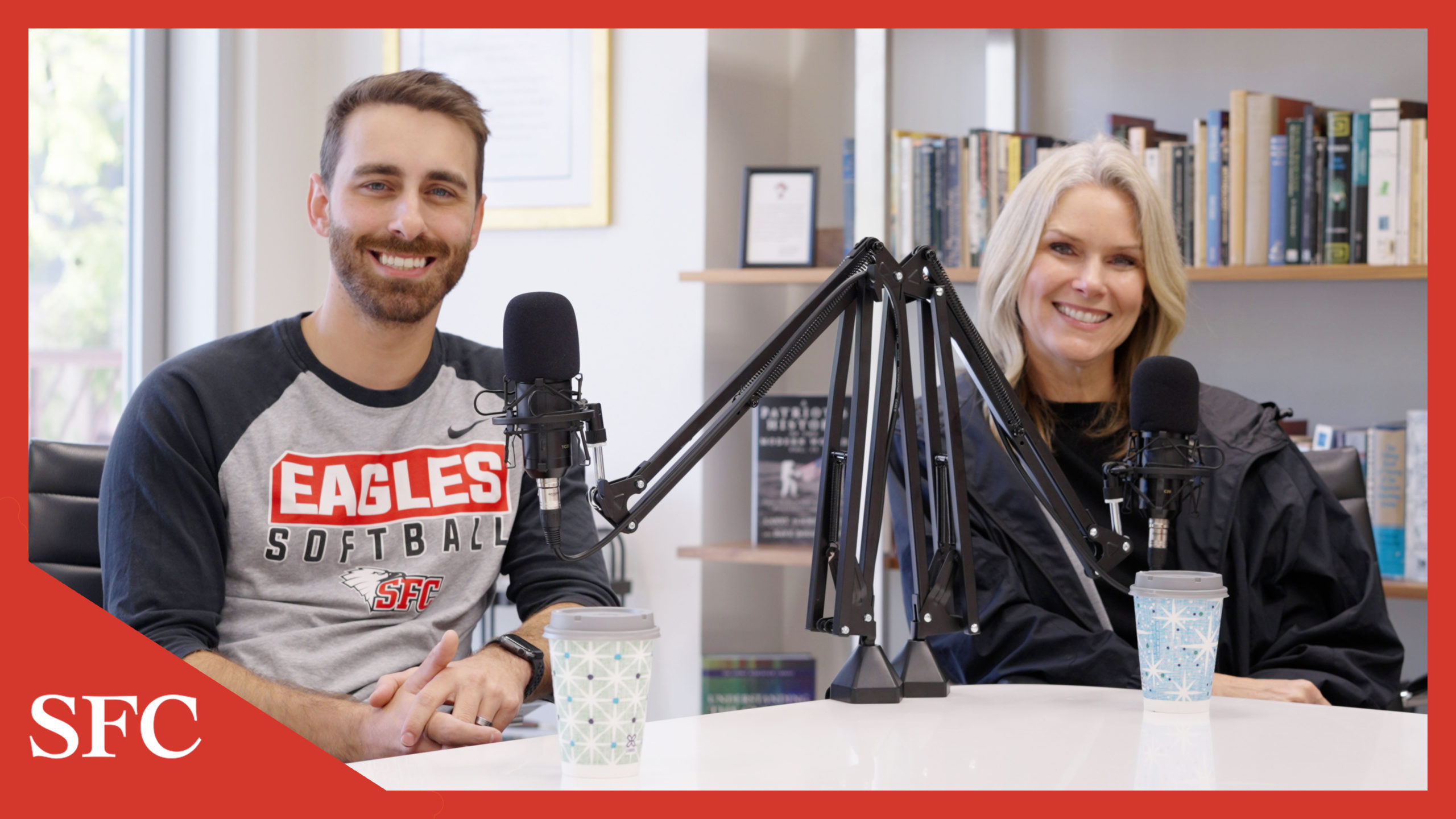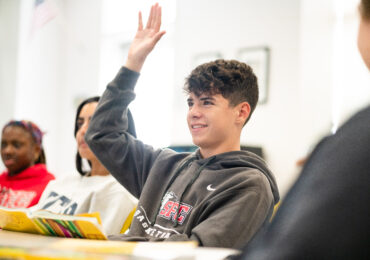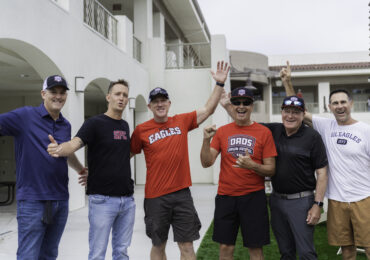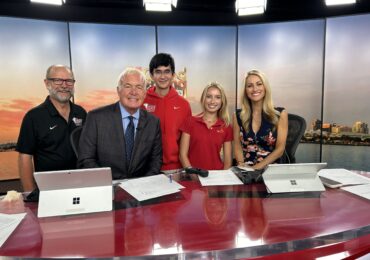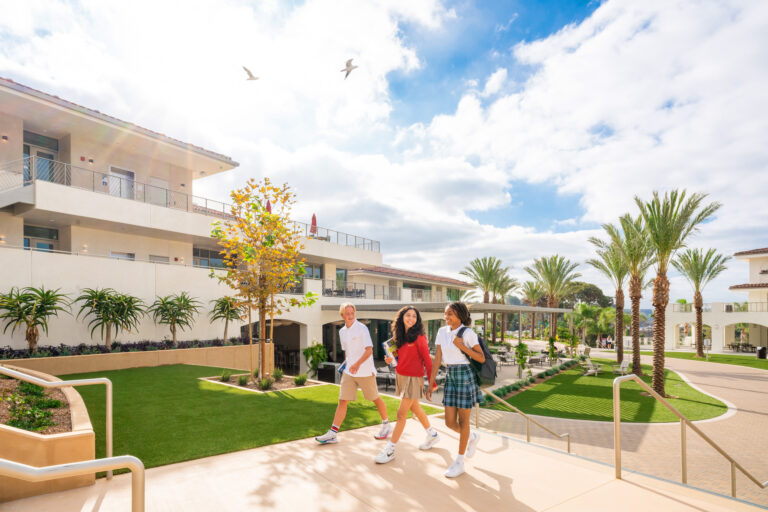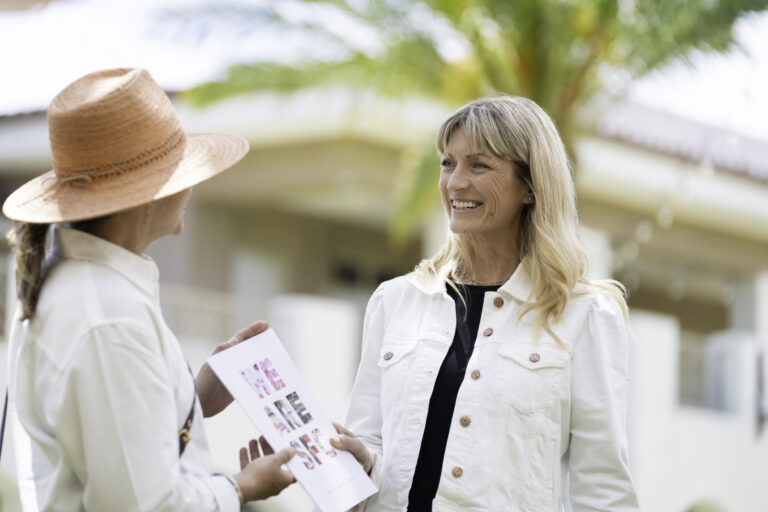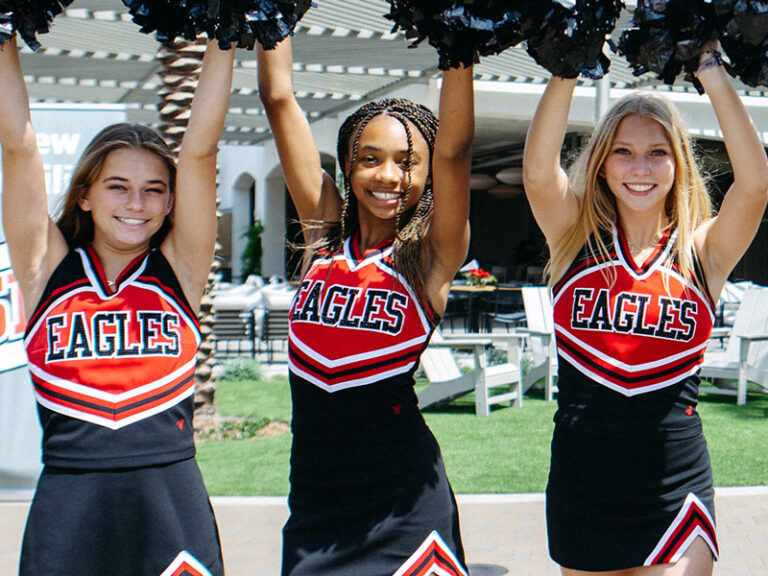Episode Show Notes
One of the most difficult challenges in today’s world – for both students and parents – is navigating social media. While social media can connect us like never before, it also comes with confusing challenges and has a significant impact on the mental and physical well-being as well as the identity formation of our students. Join Kristi, Matt, and Mike as they discuss partnering with parents and share some tools available to help students navigate social media in a positive way.
Mike Siciliano, High School Dean of Students, has a long history with Sante Fe Christian, sitting in several roles including alumnus, US history teacher, and football coach. As a student, Siciliano felt he had teachers and coaches who personally invested in him and made a huge difference in his life. Now, he tries every day to continue that legacy for current SFC students, live up to the standard his teachers set for him, and have a lot of fun.
Kristi Ellis, Middle School Assistant Principal, has worked at SFC for five years, teaching subjects like Bible, Identity and Sisterhood, and Yearbook, before stepping into her current role. Beginning her career as a high school English teacher in 1996, she has also taught middle school, homeschool, and university-level students. For several years, Kristi worked for Innovative Learning Solutions and traveled the United States assisting underperforming schools with redeveloping and revamping their curricula via teacher trainings and in-services. Most recently, she worked as a Writing Instructor at the University of San Diego’s School of Business. Kristi lives in Encinitas with her three kids, Cade, Ashley and Tyler, her husband, Jeff, and her dog, Sierra.
Matt Robinson, Middle School history teacher, has been at SFC for seven years teaching world history and the current events elective. A native San Diegan, he grew up surfing, playing guitar, and being involved in a local youth group. After graduating from Loyola Marymount in Los Angeles, Matt couldn’t wait to return to San Diego. Now, Matt and his wife live locally, lead worship at their church, and love their dog — a Rhodesian ridgeback named Rue.
Highlights
00:00:00 – Introductions
00:02:09 – Description of Middle School advisory program
00:03:07 – Discussion regarding whether or not social media is bad
00:08:34 – Effects on students of being constantly connected
00:14:27 – Failure on social media of conflict resolution
00:17:01 – Discussion about Social Institute and how it is being used at the Middle School
00:21:55 – Vast majority of schools and employers view social media channels of prospective students or employees
00:25:10 – Whether Social Institute’s principles and standards are consistent with those of the bible
00:26:39 – Discussion regarding parent tool kit
Transcript
Mike Siciliano [00:00:07] Welcome to another episode of our Eagle Perspective Podcast. I’m Mike Siciliano. We are going to be talking about social media today. I am joined by two of our middle school’s finest, our Assistant Principal, Kristi Ellis, and our Middle School World History teacher as well as the person who leads our advisory program, Matt Robinson. Thank you both for being here.
Matt Robinson [00:00:25] Thank you.
Kristi Ellis [00:00:26] For having us.
Mike Siciliano [00:00:26] It’s always fun with Middle School. That’s what I learned in my time in the High School. It’s fun down there. Why don’t you introduce yourself a little bit, your connection with Santa Fe, before we get into our conversation, and how long you’ve been here and what you do here.
Kristi Ellis [00:00:41] Okay. I’m the Assistant Principal of the Middle School, and I’ve been at Santa Fe for five-ish years. This is my third year. Got hired alongside the High School finest at the same time. What else am I saying? I love the Middle School. Mom of three.
Mike Siciliano [00:00:59] You said five years as an employee, but you’ve had kids here…
Kristi Ellis [00:01:03] The same amount of time.
Mike Siciliano [00:01:05] Okay. I thought your oldest went to the preschool here.
Kristi Ellis [00:01:07] Oh, so he did. Yes, yes. Then Cade was in public middle and public lower for a long time. Then we brought him over in ninth grade. Then Ashley and Tyler came in seventh grade. Then I started in this position a few years ago.
Mike Siciliano [00:01:23] You get to deal with all of the fun things that come up in the Middle School.
Kristi Ellis [00:01:26] I do. It’s the Wild West and wonderful. It’s all good. I love it.
Mike Siciliano [00:01:32] Matt, how about yourself?
Matt Robinson [00:01:33] This is my eighth year at Santa Fe. Taught seventh grade World History every year since I’ve been hired. I’ve also taught a current events elective a couple years. I lead our advisory curriculum, as well as I’m our chapel host for the Middle School, as well as chapel coordinator. Chapel is new this year with the Middle School. We’ve separated from the High School, which has been awesome. We’ve had some really great conversations that are relevant to our Middle Schoolers.
Mike Siciliano [00:02:01] To be clear, not that chapel is new for the Middle School.
Matt Robinson [00:02:05] No. No, no, no, no, no.
Mike Siciliano [00:02:05] Middle School specific chapel coordinator.
Matt Robinson [00:02:07] Middle School specific chapel has been really cool.
Mike Siciliano [00:02:09] Do you want to share a little bit about what advisory is in the Middle School?
Matt Robinson [00:02:13] Yeah. Advisory is this awesome time every morning that we have with… Our advisors meet with about 15 students, either all boys or all girls, and they get to really just… That’s where they start their day. It’s a great place that we maybe have announcements for the week. But throughout the week we actually get into much more deeper conversations about our faith, where we’re at, what it’s like in Middle School. We spend time in community. On Fridays we oftentimes play a game, or we have doughnuts, or something like that outside just to get to know one another and be in community with one another, which is really great. The students get to know that there’s an advisor who knows who they are to advocate for them. They have conversations with them. It’s a great place for parent touchpoints, especially with what’s going on socially with kids. If they have questions or have questions about Santa Fe, it’s a great place to always start with an advisor, someone who really knows the students and has a heartbeat for what’s going on among the students.
Mike Siciliano [00:03:07] This is a very topical topic. That’s a terrible phrase. But this is a topic that is on the minds of a lot of people—parents and people in the world—social media. It has taken over in the last 15 years or so. I remember personally I was in college when Facebook became a thing, and it came to our campus. It was like, “Oh, there’s this thing called Facebook.” I’m pretty sure my first thought was well, that’s never going to make it. What’s the point of that thing? Now it’s everywhere, and certainly, it’s everywhere with our students. There’s a lot we can talk about. We’re eventually going to get to some things that we’re doing on campus to address some of the concerns. But maybe I should start with this question: Is social media bad?
Kristi Ellis [00:03:50] Wow. I think no.
Matt Robinson [00:03:54] With many things in life, it can be bad. Absolutely, it could be used as a tool; it could also be used as a weapon. I think that’s what we’ve seen. I think every person who’s ever engaged in social media has seen the pros and the cons right at their fingertips, literally.
Kristi Ellis [00:04:11] I think it came so quickly that we weren’t equipped in how to deal with it. We did not equip our kids in how to deal with it, nor did we know the ramifications or where it would travel. Now we have that data. Finally, even the social media companies are admitting some of that data. Now we can see the toxicity of it. While it can be really helpful, which is part of our conversation today, currently, it’s not looking like it’s as helpful as it is destructive to the hearts and minds…
Mike Siciliano [00:04:51] But I think it is important for us to be clear on our position on this. It’s not that nobody should ever have social media. That’s not where we’re coming from as far as how we’re approaching it with kids, probably for a couple reasons. One, it’s totally unrealistic, but two, we have seen there are benefits of it. There is a connectedness of it. But there have clearly been some pitfalls. Maybe you guys can talk a little bit about what are some of those pitfalls that we’re seeing on campus.
Kristi Ellis [00:05:23] I would like to first say how important and incredible it was during COVID, actually. I’ll start with the positive, that there were many aspects of social media that I think saved our kids and gave them an opportunity to connect with friends, and teachers, and all of these things. There is so much good possibility in it. The things that happen on campus, I’m sure you see these come across your desk, too, Mike…
Mike Siciliano [00:05:57] No, the High Schoolers are perfect.
Kristi Ellis [00:06:01] It’s just a Middle School problem.
Mike Siciliano [00:06:02] Yeah. I’m just here to help you guys.
Kristi Ellis [00:06:06] Thank you. That’s so benevolent. I think that our students, well, they don’t know how to wield it, just like adults, actually. There is a disembodiment, I think is the technical term, where kids do and say things online that they would not do and say in person even to their friends let alone their parents. As kids are in heavy identity formation in Middle and High School and even in early stages of college, they’re spending so much time on these platforms, and it is influencing their identity. When things are not going well, or they’re being left out of things, or things are being said to them publicly or through a chat, it ends up in our offices, because people are hurt by it. The casualties are not rare; they’re common. That’s how it shows up in my office. How about you, Matt?
Matt Robinson [00:07:02] I think even as some people listen to this they’re going to be like, “Well, my kid doesn’t have social media.” But that doesn’t mean they’re not being influenced by social media. I think a lot of parents can understand that piece about oh, wait a second; my kids still text friends; they’re in group chats; they’re at a friend’s house; they’re talking about something; they’re reading a comment somewhere; they’re watching YouTube videos. There’s so many elements. I heard it once in a podcast described as our digital nervous system, that we now have this nervous system in our pockets, that essentially, we hear about something that’s going on in the whole other side of the world, and we instantly feel it. Even just events and…
Mike Siciliano [00:07:39] It’s the general connectedness. Even if it’s not a Facebook, Instagram, whatever social media app, it’s that general connectedness.
Matt Robinson [00:07:47] I think that’s why I go back to there’s so many amazing opportunities. I think about many of the designers. They’re incredible. The people that created these things are absolutely incredible individuals with amazing minds and probably have some great places where their hearts were. But then quickly it’s amazing how we as humans can create something, and then it could go awry. We know that…
Mike Siciliano [00:08:09] Unintended consequences, these unforeseen uses.
Matt Robinson [00:08:13] A lot of times it’s those random scenarios that come out of nowhere that you’re like, “Okay, how do I respond to this now?” I think that’s one of the big things that we’re looking at in the Middle School is how do we prepare students when this scenario happens? They’re not going to be able to control everything that comes their way. But really looking at how do they posture themselves and how do they respond to the situations they’re in in scenarios?
Mike Siciliano [00:08:34] Part of what we’d like to do is give students tools and a philosophy around this space, around how do I behave in the digital world in ways that are going to be productive, and good for me, and good for those around me, and not negative? Because if we don’t do that, they just wander into it and unintentionally sometimes find themselves in these situations that are unhealthy. What are some of the effects of that connectedness on kids, specific effects of kids are ultraconnected? You mentioned just the constant in-your-pocket buzz. What does that do to them?
Kristi Ellis [00:09:14] I think there is a… I don’t know if this is going to be articulated properly.
Mike Siciliano [00:09:21] It’s okay. It’s Middle School.
Kristi Ellis [00:09:22] They are thinking about it all the time. This digital life that they have is… I haven’t done the research on this, but from what I see, it has more of an effect on their everyday than we can really imagine.
Matt Robinson [00:09:41] I think it’s a safe assumption.
Kristi Ellis [00:09:45] Yes. Is that what you asked? Is it more about the impact on them? They’re thinking about it all the time, even when they’re not interacting with it. I don’t know if I answered the whole question there.
Matt Robinson [00:09:56] To go off what you’re saying there, I think… One of the things we’ll be discussing later is this program called Social Institute. With their data they’ve come to find that 60% of sixth graders nationwide have a phone. Once they get to eighth grade it jumps up to 90%. Just the fact that they have something like that in their pocket… We know it, too. Instantly your hand almost starts to reach into your pocket. You’ve got your phone. I’ve seen it with students in class. “Okay, devices closed; we’re just going to chat for a second.” Within a couple minutes it’s just like boop, and they just open it. It’s not done in a way that’s…
Mike Siciliano [00:10:29] It’s become an extension of the body.
Matt Robinson [00:10:31] Exactly. It’s boom. It’s vying for my attention. I think that idea of seeing it as a tool… Everything that we obtain we’re like, “Okay, what is this for? What’s the goal for this for me? What am I getting this thing for?” Especially with our phones or a child’s iPad. “What’s the goal of this?” I think getting them to understand there’s entertainment on here. There’s also a way for me to connect with others like we talked about. There’s a way for me to use this in my academics. That can be tough for these students to figure out where are the lines with this when I’m working on an assignment, but then a text message comes in, compared to when we were using paper…
Mike Siciliano [00:11:14] That’s hard for me. Is this confession time, where I’m answering an email, but then a text comes in, so I switch over and start responding to that? But then I get some other notification. I’m on this rabbit trail of unfinished things.
Matt Robinson [00:11:30] One hundred percent. I’m the same.
Kristi Ellis [00:11:29] You’re fully formed most days, Mike.
Mike Siciliano [00:11:34] Some people would disagree.
Kristi Ellis [00:11:36] Imagine having an adolescent brain which is just in process. Having this variety of distraction all the time is pretty tough.
Mike Siciliano [00:11:45] I think about the social implications, too. This is a question I get a lot. When I was in high school, everything had to be planned intentionally, the social events a little bit more. If you wanted to get a group together, you had to make seven different phone calls at the time.
Kristi Ellis [00:12:02] Talk to Mom first.
Mike Siciliano [00:12:06] Even more so if… If my friends all got together without me, I might not know about it.
Kristi Ellis [00:12:13] Usually, you didn’t.
Mike Siciliano [00:12:15] Now all of that happens in an instant. You know in an instant what everybody’s doing. The Snap Map where you can literally open up the map and see where all of your friends are. Selfishly, I’m glad. I’m the king of FOMO as it is. I would have been like, “Why are all those people there? Why wasn’t I invited? How come I didn’t know? All of them must hate me.” That’s what goes on.
Matt Robinson [00:12:40] There’s a false narrative that forms in your head or a narrative that is not complete. I think you touched about the speed in which this is all occurring. Just the speed and the technology. Something’s new, and then we’re trying to learn about it. We don’t know the implications of it. The speed in which things are being communicated. I think that’s one of the things that is amazing and also incredibly tough, like we talked about during COVID, this opportunity for kids to be able to connect and still have these opportunities. An amazing place to share what’s going on, to hear about a student who… It’s their birthday, and they’re just getting flooded with all these happy birthdays, and I hope you have a great day, and these fun… There’s some stuff like that where it’s… Especially a student who’s sick or something at home, and they feel alone. They feel like, “Man, I’m not going to be at school for a couple of days.” Just to see hey, they’re still connected. There’s some amazing pieces there, but that connectedness also has a dark side to it, too: a picture being shared, a situation where they feel left out, like you’re saying, and just running through those things in a way that we felt like it was a little slower. I think for them it’s very, very fast.
Kristi Ellis [00:13:48] We could be present. Our kids have the hardest time—and we do, too, as adults—being able to be where we are, because there’s something always slicing through if we allow it to. Trying to teach and learn for ourselves as adults, as well—we’re just as bad at it. Let’s just be honest—to silence our phone or figure out where the balance is for us. Is it being with your family so that you can truly experience and make memories where you are rather than constantly having a double life?
Mike Siciliano [00:14:17] Are you saying it’s unhealthy for me to wake up, roll over, and immediately check my email?
Kristi Ellis [00:14:20] Say, “Good morning phone”?
Mike Siciliano [00:14:21] That’s not a good thing? The other thing I see a lot of—and I’m curious if you see this in the Middle School, too—is the amount of conflict resolution that is attempted through digital means and just an epic failure. Don’t break up with somebody on text.
Matt Robinson [00:14:39] I was about to say, “We got to break up. It’s me, not you.”
Mike Siciliano [00:14:43] That is the worst thing. Then, even having arguments and trying to text back and forth. When we had an argument at school with a friend, we had to go home, and think about it, and wallow in it, and then we wouldn’t talk until the next day. By then we’d processed quite a bit. Now it’s this five-minute increments of like, “What should I do next? Yeah, I’ll send this.” Then another input five minutes later, and then another decision of, “What am I going to do?” which is just different.
Kristi Ellis [00:15:16] It is different. I think there’s some courageousness now to do things verbally. But it’s learned courageousness, because it is so easy to take the passive route, which is why you see even adults in comments, especially if it’s anonymous. It could be just sewage online of what people are willing to say without processing or having to see someone’s eyes or hear their tone. I keep saying to my kids, “No tone can be captured, even on text.” The emojis maybe help, but sometimes they’re passive-aggressive. Say something, and then you put in an emoji. Anyways, it’s a whole new land, which is why we’re trying to help equip our kids to be self-honoring, family honoring, God honoring through their life online as well as in person, because it is now one. That’s all a piece of who we are. We’re not just one slice. I was thinking about this this morning. How often do we just look online to see who someone is? You got your first images, and you’ve already made an assumption about someone without having any life context other than what’s been curated. Even what’s been curated is probably curated toward a certain audience or need. It’s also very inaccurate. Trying to help ourselves and our kids present and balance an accurate view of themselves and to honor the Lord in all spaces and honor their family in all spaces is a lofty goal, because we’re all working on it. But better late than never. That’s why we’re trying to help and address it, but not with that long finger of shame of oh, social media is the worst. It just needs to be done correctly.
Mike Siciliano [00:17:01] There are some hard realities in that. You probably get this. I get this question in the High School. If I don’t let my child have social media, will they be excluded? It’s hard for me, because that is a mode of organizing things, of having conversations. That’s a tough call for parents to make. I don’t want my kids exposed and dealing with all this stuff, so I’m going to take social media away. But the flip side of that is they may be excluded from some things. Maybe that is a cost that is worth having. Parents will make their own choices on that. I think where we’re coming from is acknowledging for a lot of people at least at some point in life this is going to be a part of life. How do we do it in a way that is positive? You mentioned Social Institute. Maybe we transition and talk about that a little bit. It’s a partner that we’ve had for about a year now we’re just starting to lean into a little bit. Do you want to share a little bit about Social Institute and maybe even how you’re going to use it in the Middle School as well?
Matt Robinson [00:18:12] Social Institute is a program led by Laura Tierney. She has worked with social media through various organizations as well as some schools like Duke. She played collegiate basketball, I believe. Essentially, she has witnessed the goods and the bads of social media in her research and with her team. They decided to come up with this program called Social Institute to really help students understand how do I use this as something to build people up in a positive manner, not just talking about the negatives, not scaring them, not using just fear all the time, but really trying to be authentic and real with them, and seeing how do you use this in a positive light. I think for us in our DNA, being Santa Fe Christian, we want to be that positive, but we also want it to be Christ-like. This idea of what if a bunch of first century Christians had cell phones, how would they have used social media? How would they have used…? What would it have been like for them in the digital world? That’s what we’re looking at now today. There’s seven different standards that they use. It’s amazing, because what they do in the… While we’re going to use it in advisories, it’s got a gamification to it. It will throw up a scenario, something that would have happened, maybe something they read, or something that was passed around, or something they heard from another student, something having to do with media, technology. The students will have four different kinds of responses they can pick from. Individually they’ll do it on a device. It’s just between them, and it’s anonymous in a way. They’ll pick however they would respond to it, and then after the time limit—it’s got 30 seconds to answer it—it will show the results: 60% of the class picked A, or B, or C depending on how to respond to the situation. Then it will show across the school, what did the rest of the seventh graders say? What’s the percentage? Then it goes nationally. The students can see oh, wow, a lot of us are in this boat, or oh, I’m actually a little bit more different in how I respond to that. It frames for a conversation to happen. This is where the advisor is pivotal. They know these students. They have a little bit of a background of what’s going on in their lives. They have a Christ-like perspective that they’re able to be like, “Okay, how do we respond to this? Where are we at in this situation as a school, as a community, as a Christian?” That’s essentially how we’re going to use it in the classroom. What’s great is in the program it also has student voices—students from High School, students from Middle School, college that have dealt with some of these situations, Olympic athletes—that shared their perspective on it, too. They’ve recorded it and chosen to share it with this program. It usually does about three scenarios per lesson. Some of these standards include finding your influencers. Who are the people influencing you? What are the programs actually influencing you? Who are you constantly listening to or watching? Cyberback. How do you actually stand up for a friend? Rather than watching out for cyberbullying, how do you actually make sure you’re like wait a second, my friends are being harassed? What is the steps to take in order to stand up to them, stand up in a healthy way, in a way that’s going to protect them and your friends? Striking a balance in their life in management of this and protecting their privacy. How do they actually protect their privacy at this age? Really, the core one is… Playing to the core is what it’s called. Really, that goes back to that identity, that Middle School and High School there’s so much identity formation happening. Who am I? This is an extension of who I am now. This digital world, we’re in it now. This is where we’re at. To think that oh, my life and who I am as a person stops right when I pick up a phone is a lie. It’s a lie. Literally, the enemy would love for you to…
Mike Siciliano [00:21:55] Listen, to build on that one, because I used this a little bit with the freshmen this year. I did a lesson out of play to your core which gets at this idea of does your online presence… If someone who doesn’t know you looks at everything you do online, what will that say about you that match your stated values? The scenario in the one I used with them, it asked a question about… It’s did you know that more than two-thirds of colleges or employers will look through your social media before making a decision on you? Do you think that’s fair? Kids will answer, but at the end…
Kristi Ellis [00:22:33] Doesn’t really matter.
Mike Siciliano [00:22:35] Whether you think it’s fair or not, it will happen. It gets them into this conversation about how does that change or make you think when you’re about to post something. Do you want to make fun of your buddy? Sure, maybe your buddy really is fine with it, and maybe you have that kind of relationship, but what kind of picture does it paint about yourself and the things you represent if someone sees that in three years? What kind of conclusion are they going to draw about you?
Matt Robinson [00:23:03] I like that you mentioned that you are using it with the ninth grade, because it is grade specific. They definitely have worked with educators; they’ve worked with families; they’ve worked with students to understand hey, what a sixth grader is going through is different from a ninth grader. That’s what I really love about it. It is differentiated per grade level and age level. It is appropriate to hey, this is what your… This is relevant to where the sixth graders are at. To go off, it’s not just social media. It’s going back to those text messages. It’s going back to those places where the things are being shared, even in a Google Doc. You think, “Oh, but those are used in the classroom for writing a paper.” There’s also chat functions and sharing. Those are all places, those are all fair game in the technical world of where identity can be displayed.
Kristi Ellis [00:23:53] I love the program spends so much time asking kids how it’s working before they send it out, because our kids hear so much of the no’s, like we talked about, and this is engaging to them; it’s fun for them; and it’s friendly. It gets them thinking without feeling like just one more rule from the old folks, who are the worst. I love that the Social Institute does use kids to make sure that this is all ready to go in the classroom. They have the biggest voice in there, which is really healthy.
Matt Robinson [00:24:29] I was just going to say we did try it out a little bit at the end of last year, just practice it, practice the program. At the end of the year one of our reps with Social Institute told us, “Okay, well, we’re going to send you guys new lessons in August.” I was like, “What was wrong the other lessons?” What I loved about the response is, “Hey, we’re always learning; things are changing.” I think that’s exactly what you were talking about.
Mike Siciliano [00:24:50] Shout-out to Josh.
Matt Robinson [00:24:51] Yeah, Josh. Josh was patient with us. He’s an awesome individual. I think that is a great heart, because I think that’s exactly where we’re at, too, is we’re always learning, we’re always growing. I think that’s exactly their perspective, too, as an organization, and I respect that.
Mike Siciliano [00:25:10] We should be clear about Social Institute. They are not a Christian organization in the sense of they’re only working with Christian schools, although they are working with a lot of Christian schools. Having looked through a bunch of the lessons, would you say it’s accurate that the principles and the standards are consistent with Christian biblical principles as far as what kids are going to walk away with?
Matt Robinson [00:25:30] They are.
Kristi Ellis [00:25:32] One hundred percent, yes.
Matt Robinson [00:25:34] I think that’s a great place for our advisors to step in, too, that we can add to the conversation and grow it. There’s several Christian schools across the country who have chosen to use this program because it’s a framework. I think that’s what I really love about Josh. He says, “Hey, this is something to start with, and then you make it specific, and you grow it to your school and the DNA in your school,” like I mentioned earlier. I think it’s a beautiful thing. It’s great.
Kristi Ellis [00:25:55] It is. I think for our kids, where do they have the most influence in their lives right now? It’s on their phones. Not only the phone but all the social media platforms. Equipping them, and our teachers are excited about that.
Matt Robinson [00:26:09] Trying to get more of that positive mindset. That was something that they had mentioned themselves about how they started. I think a lot of the kids felt like, “Oh, it’s another one,” like you’re saying, and they were like, “Okay, yeah. How do we do this balance? How do we talk about the dangers of it but also hey, how do we change this? How can we begin changing the perspective of how this is used?”
Mike Siciliano [00:26:30] It gives them ownership of it. It’s not a bunch of adults being like, “Hey, this is bad.”
Matt Robinson [00:26:36] Absolutely. I love that ownership piece.
Mike Siciliano [00:26:39] One other piece of this that I think is really important is there’s a parent component to this, which I know we’re going to be rolling out here soon. It’s called the parent tool kit. You just want to talk about that a little bit on what that is?
Kristi Ellis [00:26:53] Sure. For as much as we can do in advisory and systematically at Santa Fe, obviously, our partnership with parents is the most important piece. As a parent myself I’m often curious what’s this new app? A few years ago before TikTok it was like, “What’s TikTok?” I thought it was only about the dancing out in front of our classrooms that we would see all over campus.
Matt Robinson [00:27:17] Mr. Robinson, can you be in this TikTok?
Mike Siciliano [00:27:21] Who sees it, and what’s going to happen?
Matt Robinson [00:27:25] Who sees it? What’s going to happen? Get out. Close the door.
Mike Siciliano [00:27:24] Who cares? Just be in it.
Kristi Ellis [00:27:26] Again, it seemed like no big deal. There are so many aspects of TikTok that are no big deal. That being said, there are landmines in there. Mike and I have waded through some pretty deep dives into TikTok. It can be really disheartening, to say the least. All that to say the parent tool kit is… For me if I’m like, “Oh, there’s this new app coming out, Yik Yak…” That’s actually one.
Matt Robinson [00:27:52] Yeah, there is one. I don’t know that much about it.
Kristi Ellis [00:28:02] Anyway, I can go to this parent tool kit. Ironically, it’s online. But I go online, and I read about it, and I can see the backdrop of it, what it’s all about, pitfalls, pros and cons, ways to shepherd it in my own home. It catches me up to the degree that I can be caught up, not being a student, with what it’s all about and hopefully, gives me language to talk with my own kids about it and to decide ultimately if that’s something that I would approve for the device. We’re excited about that aspect of the parent tool kit. Really hope that parents take advantage of it, read about it, and really use it in their home.
Matt Robinson [00:28:43] Yeah. There’s also an opportunity for them to even ask questions at the bottom, or ask about an app, or bring up an app, because, like we said, things are happening so quickly. It’s very much like, “Hey I just heard about this.”
Mike Siciliano [00:28:53] They’re really good about an album comes out and several weeks later there’s a new topic in the parent tool kit of here’s the app, here’s what we’ve seen so far, here’s what we’re not sure about, here’s what we’re concerned about. We’d recommend you enable this setting or disable this feature. It just hopefully can become an easy stop to learn about some of these things that you’re hearing. Parents get surprised. One specific one I’ll say—and we’ve said this amongst our community—Snapchat, very popular right now. A lot of parents don’t realize that you can do financial transactions on Snapchat. You can buy drugs from people on Snapchat. Those are dangers that… Not saying everyone who’s on Snapchat is doing that, but that you want to be aware of as a parent and maybe disable that feature. Hopefully, this is a way to educate parents on those things.
Kristi Ellis [00:29:48] Give our parents an opportunity to… I really think, too, just partnering with the kids, that getting the kids… They’re not going to understand everything, of course. We’re still setting the guidelines, because we’re the parents. Yeah, kids were parents. But I think it’s so important. When our kids are little if they are getting punched in the sandbox, we’re not going to just leave them in the sandbox. We’re going to take them out and talk to them about how to deal with these things when they’re little. But now we have a digital sandbox, and it can be brutal in there. It can be fine—just keep the metaphor going—building all the things and have a wonderful time. It can also be destructive and dangerous. It’s our job to be aware of what’s going on in their sandbox, and to equip ourselves the best we can, and for them to know that’s what we’re doing. That’s part of the conversation.
Matt Robinson [00:30:37] I think it does take a partnership between the school and parents. I think especially with the Social Institute program, students are going to be engaging with it every other week in our advisory. When a student comes home and is talking about it, talk to your kids about it. “Oh, my gosh, what a great opportunity.” Or when they come home, “Oh, we’re learning about social media.” They just have this already…
Mike Siciliano [00:30:59] Or how about, “What did you do at school today?” “Nothing.”
Matt Robinson [00:31:02] Yeah. I think those opportunities, if they come up, man, jump on them as a parent. Man, I think I’m preaching to the choir there. I just think this is a good opportunity to open up some of those conversations with the advisors. The advisors are going to be leading and being a part of these conversations. It’s a great opportunity. Great opportunity, I think.
Mike Siciliano [00:31:25] All that said, I think it’s also important that we say we recognize that this is not the answer to all of our community’s problems. It’s not the cure-all. It’s a tool. We’re going to try it, but ultimately, our parents have the most influence over their kids, and ultimately, there may be other things that we add and adjust to. This is something we’re excited about moving forward with right now. But this is an ever-evolving landscape.
Kristi Ellis [00:31:55] Ever-evolving, yeah. Just getting started, planting some seeds.
Mike Siciliano [00:31:59] Well, good. I can’t say thank you enough to both of you for being here.
Kristi Ellis [00:32:03] You could text that later.
Matt Robinson [00:32:04] Yeah absolutely.
Mike Siciliano [00:32:04] Well, I was going to say Instagram is my preferred method of communication. Are you more of a Snapchat person?
Matt Robinson [00:32:10] I took a hiatus from Instagram for a year. I just came back after a year.
Kristi Ellis [00:32:15] Really on a hiatus.
Matt Robinson [00:32:17] I know. I took one year.
Kristi Ellis [00:32:18] I haven’t been on it that long.
Mike Siciliano [00:32:18] I am still all in, let me tell you. My phone’s buzzed four times since we’ve been sitting here, because someone liked my post.
Matt Robinson [00:32:25] You need a year to ditch it. You’re like, “I got to see it.”
Mike Siciliano [00:32:28] Well, we are very lucky to have the two of you in the Middle School and leading our efforts on this down there. Can’t say thank you enough for your impact on our kids and our community and for joining us on the podcast.
Kristi Ellis [00:32:39] Well, thank you, Mike. Likewise from the High School. Thank you.
Matt Robinson [00:32:40] Hey, thank you so much for your time.
Mike Siciliano [00:32:42] It is my pleasure. We’ll do this again sometime soon. Thank you so much again for joining us on another episode of our Eagle Perspective Podcast. If this is your first time listening or watching us, you can always catch us on Apple Music or Spotify. You can watch video podcasts on YouTube, or you can find us on other places where podcasts are available. We look forward to seeing you again soon.
